Managing for wildlife
When you create a nest box project for Tree Swallows you become a wildlife manager. To become a good, effective wildlife manager you must learn the essentials about the animal you plan to manage. You need to know where it lives, how it lives, and what it needs to survive, flourish and reproduce. Therefore, creating a good, effective Tree Swallow nest box project requires learning some basic Tree Swallow characteristics and nesting requirements. For instance:
What do Tree Swallows look like?
Tree Swallows, scientific name Tachycineta bicolor, are small songbirds. Like all swallows they are fast, agile fliers that catch insects in their mouths as they fly. Tree Swallows show the typical swallow body plan, which is:
- Slender, streamlined bodies with short necks.
- Long, pointed wings.
- Small bills (but mouths that open wide).
- Very short legs with small feet
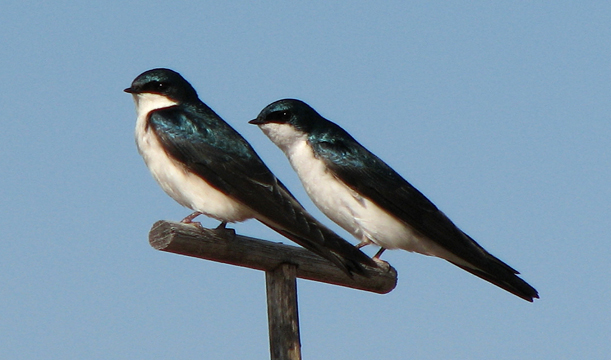
All adult male and most adult female Tree Swallows can be told from other swallows by their:
- Shiny, iridescent blue upper body and head.
- Pure white throat and body underside.
- However, Tree Swallow females in the spring of their second calendar year of life (their first nesting season) have a unique sub-adult plumage. At this one time in their lives females of this species show a mix of brown and greenish upper body feathers. The second-year adult female Tree Swallow in Euan Reid’s photo below is typical.
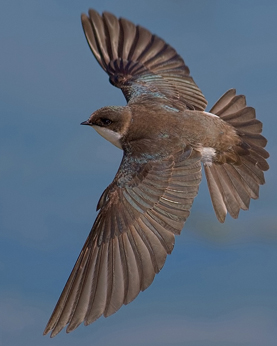
- Juveniles, young Tree Swallows that have recently left their nests and have not begun molt, are sooty gray-brown above and white underneath. During this brief stage they show no blue or greenish feathers.
- Photo below by John Gavin.
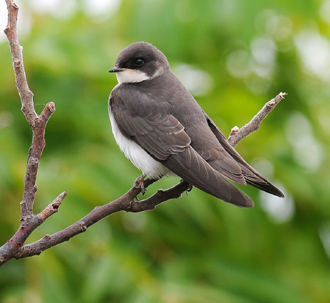
- For more on plumage differences see Sexing and Aging Tree Swallows.
Where do Tree Swallows live during the nesting season?
- Tree Swallows nest from subarctic northern Canada and Alaska south through much of the United States.
- The green areas of the map below show their main breeding range, but they nest locally farther south.
- Note the very large area of the North American continent where Tree Swallows may be found nesting.
- However, realize their nesting population is not spread equally across this range. In any given place they may vary from rare to abundant.
- Field guides, local bird clubs, or state conservation departments can tell you if Tree Swallows nest where you live.
- Tree Swallows winter from Florida and the Gulf Coast south into Mexico, Central America, and the Caribbean. As you can see, their winter range (red area of the map) is much smaller than their nesting range.
- Very specific range and occurrence data for Tree Swallows and other birds can be found by exploring the eBird database.
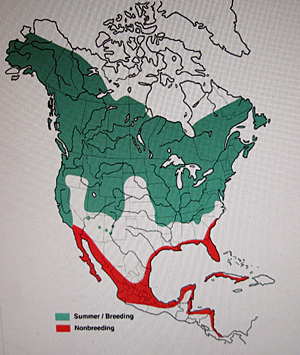
What do Tree Swallows eat?
- All swallows are aerial insectivores: highly-maneuverable, active-pursuit predators that feed mainly on insects they hunt, chase, catch and eat in flight, as the Tree Swallow in Robert Whitney’s photo below is about to do.
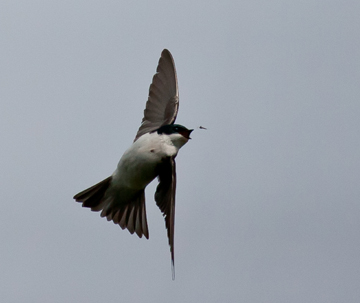
- Aquatic insects of the Order Diptera, the true flies, are the most common prey taken, but Ephemeroptera (mayflies), and Odonata (dragonflies) are also preferred prey.
- They also eat a variety of terrestrial insects.
- However, unlike other swallows, Tree Swallows eat certain berries when and where they are available, especially those of bayberry and waxmyrtle. These berries become very important sources of food in autumn and winter.
How do Tree Swallows drink?
- Because they are such skillful fliers Tree Swallows are able to drink and bathe on the wing.
- You can see several of the birds in the photo below by Stephen Kolbe dipping their lower bills into the water.
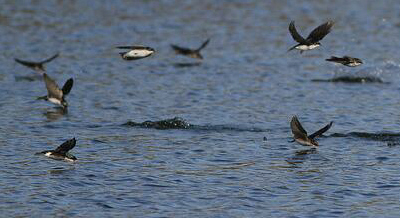
Now you know some basic Tree Swallow characteristics, but what are their requirements for nesting habitat?
- Under natural conditions, Tree Swallows prefer to nest near or in wetlands, such as marshes, swamps, beaver ponds, and wet meadows.
- These wetlands are usually rather open for easy, unimpeded flight and have lots of the flying insects Tree Swallows prefer to feed themselves and their young.
- Perhaps most important, wetlands often have nest sites Tree Swallows need.
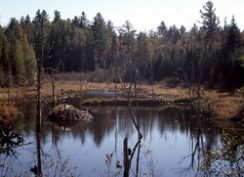


Where do Tree Swallows build their nests under natural conditions?
- Tree Swallows are cavity-nesters. Originally they nested inside holes in trees.
- However, Tree Swallows are what’s technically called “obligate secondary cavity-nesters.” This big term simply means they are birds that have to nest inside cavities but can’t dig their own nest holes.
- Therefore, under natural conditions they must find, claim and hold possession of an old woodpecker hole or a natural cavity in a dead tree if they are going to raise any young.
- Photo below by Heather V. Hogg.
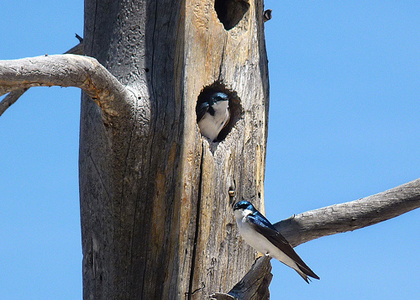
- Perhaps because there is usually a shortage of natural nest sites, Tree Swallows quickly accept nest boxes, even ones far from water.
- And although they are not colonial like some other swallow species, pairs of Tree Swallows will nest as close as 100′ from one another if there are suitable nest sites and a good food supply. This lets us create Tree Swallow projects with multi-box grids.
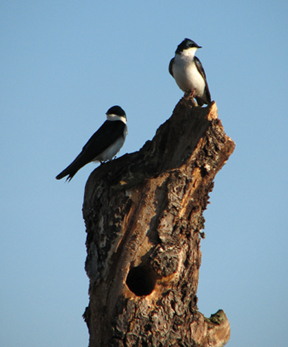
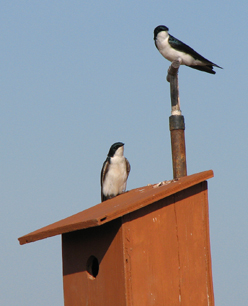
- Like most songbirds, Tree Swallows are short-lived. This means they seldom get more than one or two chances to breed. This, plus the shortage of nest sites, leads some Tree Swallows to try nesting in risky or inappropriate situations.
- Photo below by Cheryl Sutton.
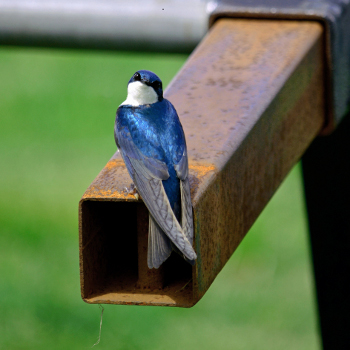
Now you know the basic Tree Swallow characteristics and nesting requirements. You are going to learn a tremendous number of other things about Tree Swallows, but understanding these essentials lets you take your next important step: finding a good location for locating your successful nest box project.
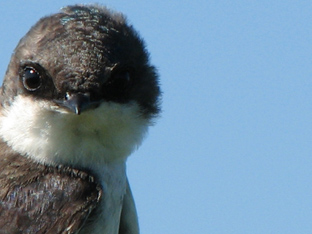
Click here for your Next Step:
Finding Good Sites for Tree Swallow Nest Boxes
———————————————————————————-
Home: Tree Swallow Nest Box Projects
Creating Tree Swallow Nest Box Projects
Spring Return
Nesting Season Behavior
Song and Calls
Nest Site Claiming
Pair Formation
Nest Building
Bird Flight
Mating and Paternity
Diary of One Season at Salmon Creek
Monitoring Nest Boxes and Keeping Records
Making Box Checks Keeping Box Records Control Sheets Season Summaries Print Sheets
Banding Your Tree Swallows Banding Adults Banding Nestlings
Tree Swallows in Research Research Bibliography Glossary of Terms